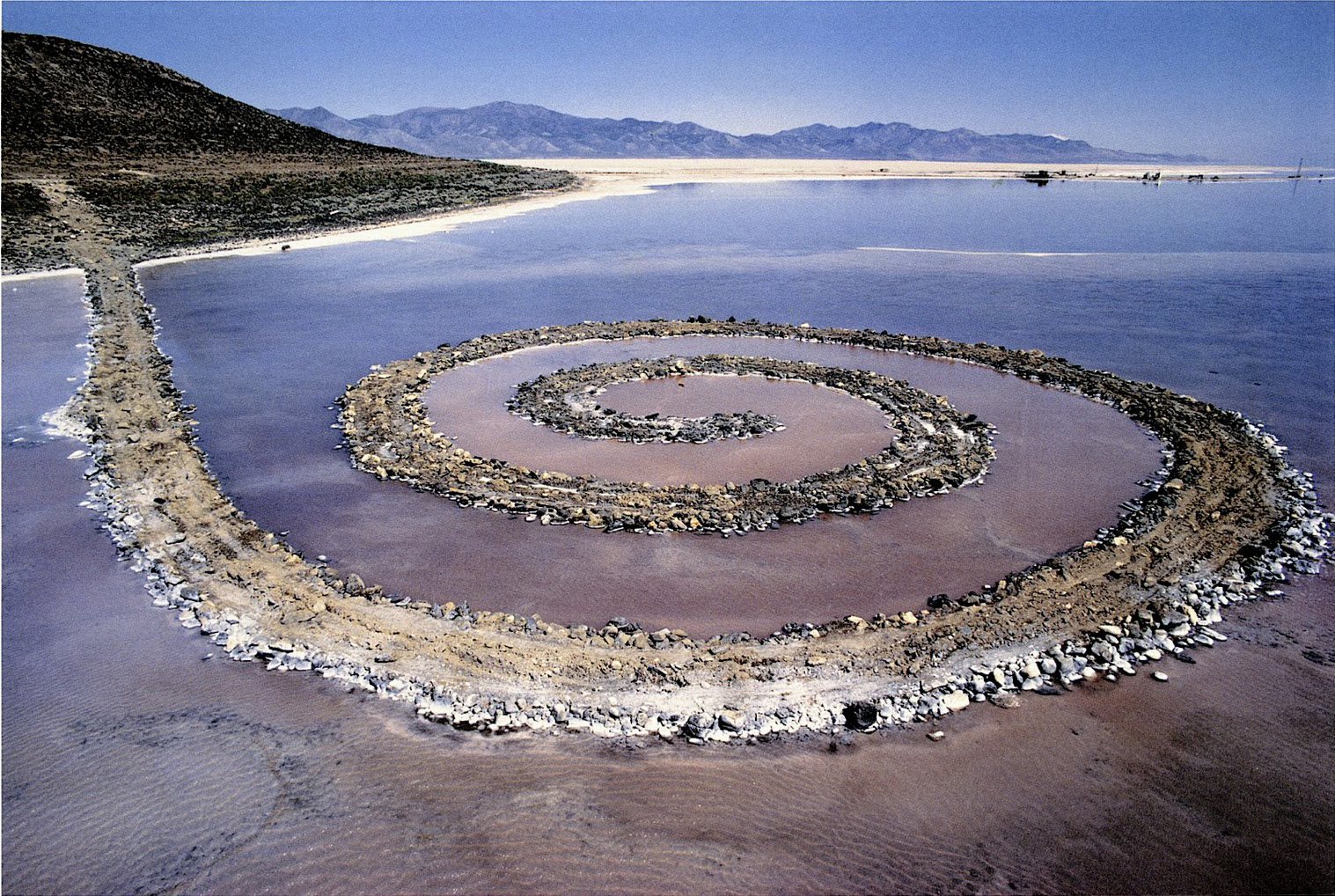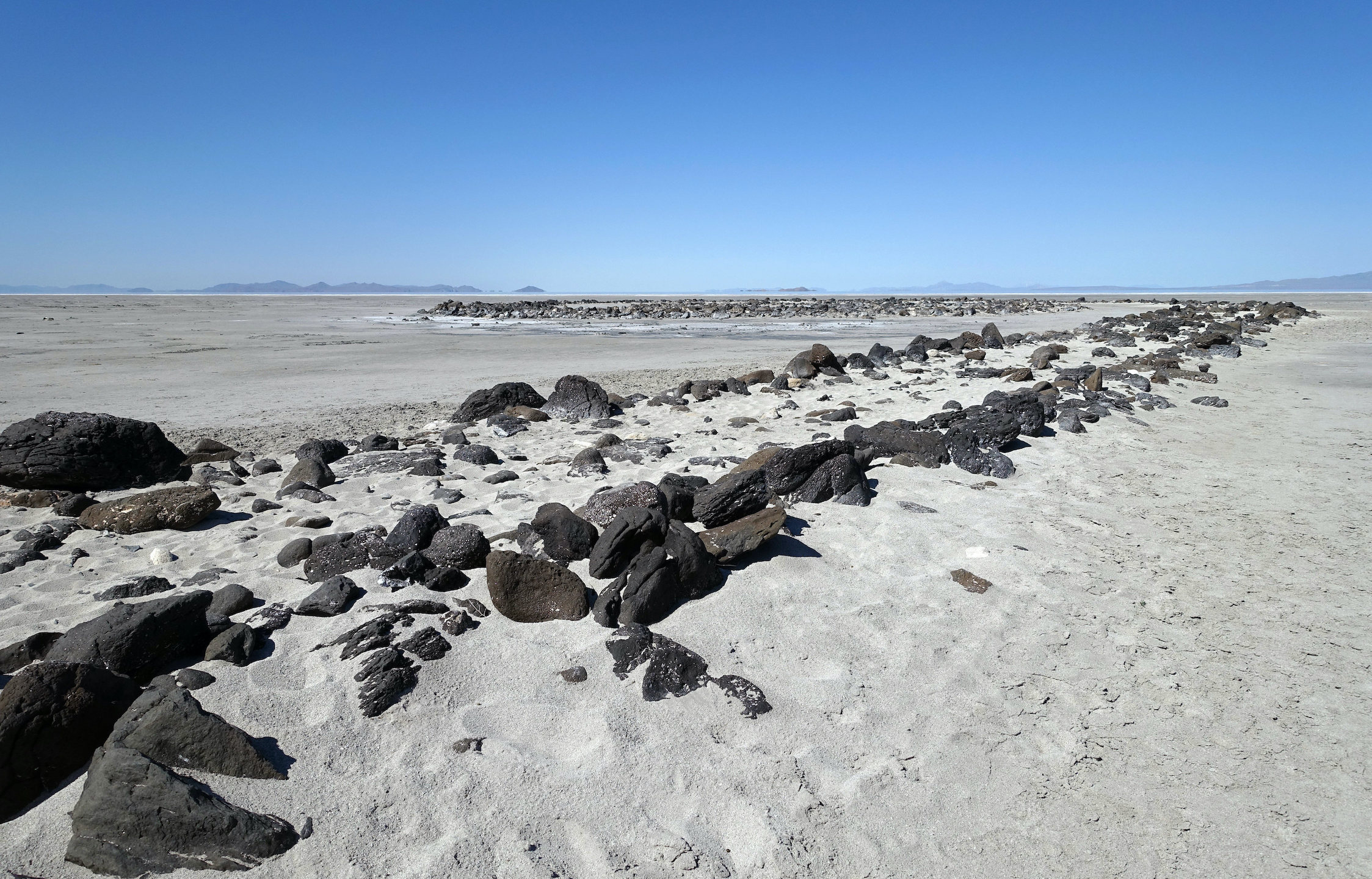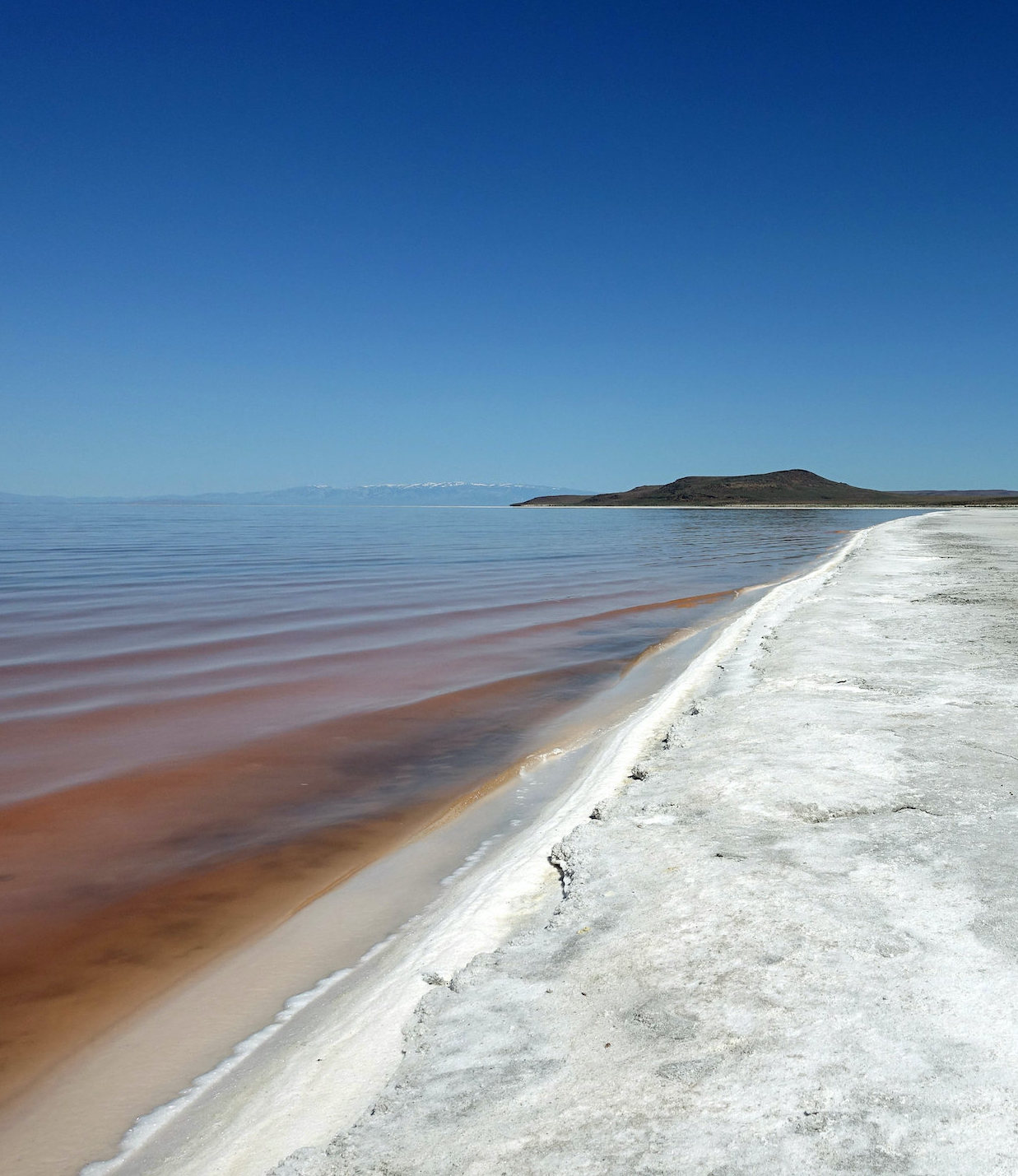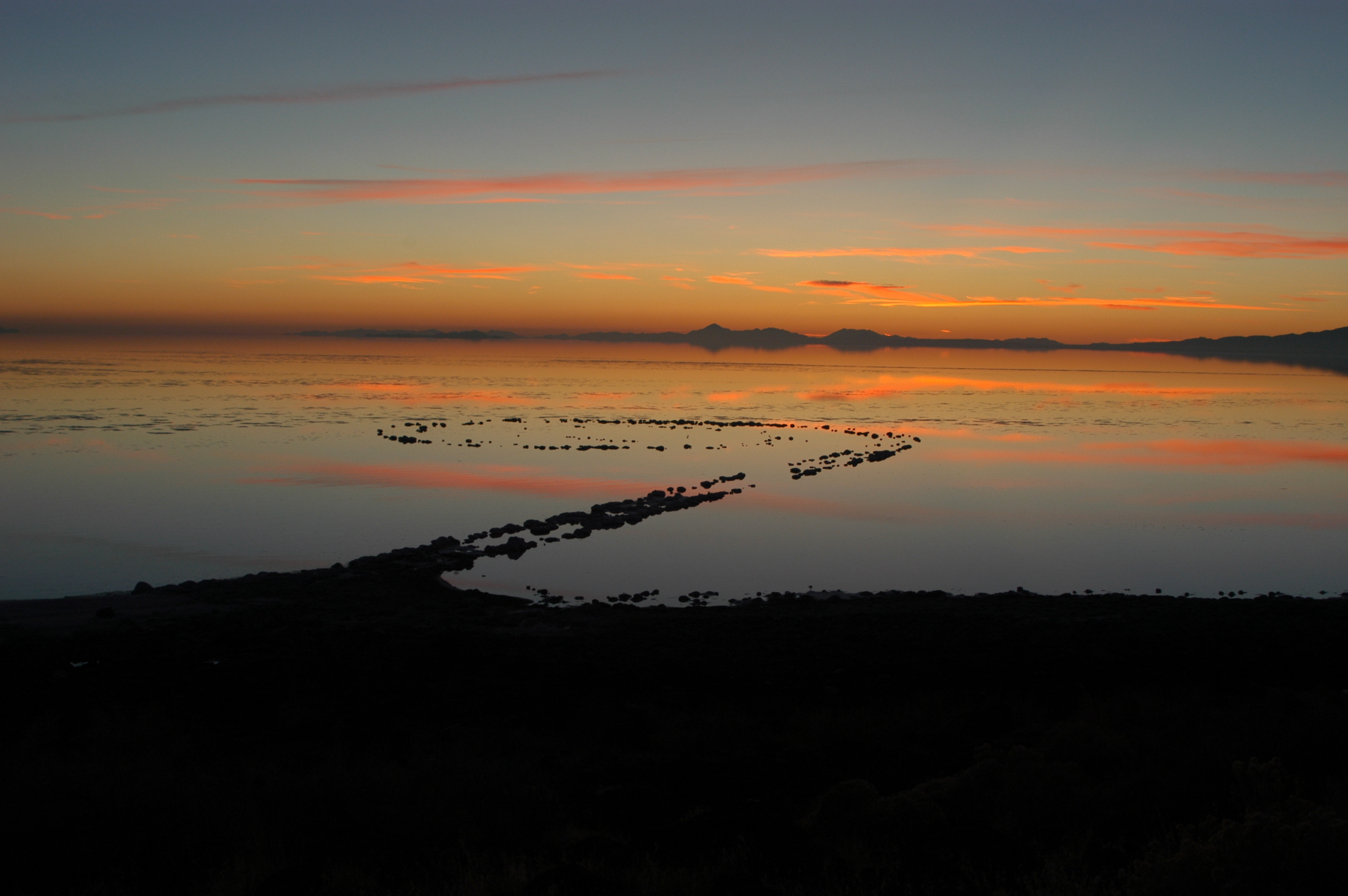Robert Smithson, Spiral Jetty, 1970, Rozel Point, Great Salt Lake, Utah, 1500 (if unwound) x 15 foot spiral, basalt, sand, and soil ©Holt-Smithson Foundation. Speakers: Dr. Steven Zucker and Dr. Beth Harris.
[0:00] [music]
Dr. Steven Zucker: [0:07] In 1970, Robert Smithson hired several people to help him create “Spiral Jetty.” We’re standing right in the middle, at the edge of the Great Salt Lake in Utah.
Dr. Beth Harris: [0:18] But we’re not seeing this the way that it existed when Smithson first created it, where it was an intersection between the land and the very odd water of the Great Salt Lake.
Dr. Zucker: [0:30] This is a terminal basin, a huge lake that had been largely fresh water, but there is no outlet. The water, once it flows here from rivers and streams, collects and then simply evaporates, which means that the water is dense with minerals.
Dr. Harris: [0:44] And especially with salt, very much like the Dead Sea in the Middle East, and this is one of a handful of these terminal basins that exist in the world.
Dr. Zucker: [0:52] Almost nothing can live here. There are a few fish that live at the outlet of some of the freshwater rivers and…
Dr. Harris: [0:59] And there are brine shrimp and algae. In fact, there’s a particular kind of algae that makes the water turn pinkish-red. That was true when Smithson created “Spiral Jetty,” but today, as we look out at the lake, it’s blue.
Dr. Zucker: [1:12] With help from the Dawn Gallery, which represented him, Smithson was able to bring a front loader and dump trucks, a tractor, to help move these basalt stones, and sand, and some soil into place.
Dr. Harris: [1:24] By creating a spiral, Smithson created lots of opportunities where the land and the water could meet one another.
Dr. Zucker: [1:32] Right now, because the American West is in the midst of a drought, the water has receded and is at a great distance from this earthwork.
Dr. Harris: [1:39] Instead of the water filling the spaces in between the spiral, we have sand. This was very much meant to be a work of art that changed based on natural principles.
Dr. Zucker: [1:51] Smithson was interested in the idea of entropy, the idea of the way things break down. His intervention in this natural landscape, it’s an expression of the way in which artists thought about the landscape for many years.
Dr. Harris: [2:05] We could go back to artists like Caspar David Friedrich, who thought about the overwhelming size and power of nature and the smallness of man. That’s certainly one of the themes here, for me, as we stand here.
[2:18] We could also think about the importance of the vastness of the American landscape in 19th-century American painting, or even its importance to the Abstract Expressionists in the 1950s.
Dr. Zucker: [2:28] We can go even further back and look at the artwork of Indigenous peoples in the Americas long before the Europeans arrived, the geoglyphs, better known as the Nazca Lines, in Peru in South America, or the earthworks that come out of the Fort Ancient culture in North America.
[2:43] In fact, the very shape of “Spiral Jetty” is a form that has shown up in petroglyphs throughout the American West.
Dr. Harris: [2:51] And it’s a form that appears in nature quite frequently.
Dr. Zucker: [2:54] One of the anecdotes that Smithson apparently was aware of was the centuries-old idea that the Great Salt Lake contained a whirlpool that somehow connected it to the Pacific Ocean. The idea of a spiral or whirlpool is active even in the stories that predate Smithson.
[3:10] This is also a sculpture that is rooted in the 20th century, in an industrial culture. 1970 was the year of the first Earth Day, and that signaled an important early moment in the environmental movement. The idea of the ruination that man was visiting on nature is clearly informing work like this.
Dr. Harris: [3:29] Earth Day being this time when we reflect on environmental issues, but the relationship between the growing industrial nature of the United States and the amazingly beautiful, vast, virgin landscape that was here when Europeans arrived is a theme throughout 19th-century American painting.
[3:46] As we stand here, we see mountains. We see this basalt that’s formed from a volcano. We have a very powerful sense of the passage of time that I think was very interesting to Smithson. By putting art outside in the world, it becomes part of the process of nature, it can’t be conserved.
Dr. Zucker: [4:05] In 1970, this was still a radical idea, the idea of taking art off the wall, bringing it outside of the confines of a home or a museum.
Dr. Harris: [4:15] And thereby outside of the commercial, of a work that could be bought and sold.
Dr. Zucker: [4:20] Smithson was interested in creating a porous relationship between that more controlled gallery experience and the experience of art in the world. So, can a work like this also exist in Manhattan, can it also exist in a gallery?
Dr. Harris: [4:32] Well, we did drive two hours from Salt Lake City. One does have to make an intentional pilgrimage. To see this, we’re really in the middle of a vast, empty space in the American West.
Dr. Zucker: [4:46] Yet this artwork was not conceived of as existing only here.
Dr. Harris: [4:50] There’s a video, there are aerial photographs. Like many works of art in the 1960s and ’70s that were ephemeral, they exist through their documentation. Although this still exists here also.
Dr. Zucker: [5:01] I have to say, I wouldn’t feel as if I had experienced this work of art fully had I not come out here.
Dr. Harris: [5:05] Standing here looking at “Spiral Jetty” and being really aware of how different it is than when Smithson created it in 1970. Really makes me think about museums as places where we entrust works of art.
[5:17] We lock them away from time. We conserve them and create special conditions to stop time from hurting them. But here Smithson created something that time is supposed to change.
Dr. Zucker: [5:30] Museums in a sense try to do the impossible, which raises a really interesting question. What [do] we do with this significant work of art that was intended to change over time?
[5:39] This work of art and the land that it sits on came under the control of the Dia Art Foundation. What does an institution like Dia do with something like this? Does it try to protect it? Does it allow natural and industrial forces to play with the landscape around it?
[5:53] What Dia did is, in concert with the Getty Conservation Institute, is to make the decision to regularly document this object.
Dr. Harris: [5:59] You mentioned this idea of entropy, which was so important to Smithson. This idea that the tendency of all things, according to the laws of physics, is to move from order to disorder, to chaos, and I think we have that sense of things coming apart here.
Dr. Zucker: [6:17] Smithson is imposing geometric order into this natural landscape, into this vast space that is in the process over millions of years of disassembling. Here, more specifically, we can see the way his intervention is slowly coming apart.
Dr. Harris: [6:31] I think that sense that over millions of years this will come apart makes us aware of the brevity of our own life spans in the grandeur of time.
[6:41] [background sounds only]
A monument to paradox and transience
A loud abrasive buzzing bellows from the nightstand and I raise my head, only to be blinded by the red light emanating from the small—in size, not volume—machine against a backdrop of pure blackness. 4:00 A.M. Oy. I’m immediately beset by the eternal morning conflict: ten more minutes of sleep vs. the rush of adrenaline that wants to start the adventures that await. The latter quickly usurps the former as I realize today is September 25th, a day I’ve waited for my entire life (metaphorically speaking) and actually been counting down to since the spring. It’s Spiral Jetty day.

Robert Smithson, Spiral Jetty, 1970 (Great Salt Lake, Utah) (photo: Gianfranco Gorgoni) ©Holt-Smithson Foundation
I bound out of bed, Gianfranco Gorgoni’s seminal photograph of Robert Smithson’s iconic earth work on repeat in my head as I shower and “pack” for the daylong adventure that will take me to a remote area of Utah. I meet the rest of my party at the gate at LAX and it’s immediately clear from the conversation that we’ve all arrived at this moment with decades of expectation accumulated. How would the experience compare to the visions (particular to each person) we had all conjured up over the years? Would the jetty “deliver” the transformative experience we all sought? Or would it fall victim to a case of excessively high and unattainable expectations? Time would tell.
But, it would indeed take time. An hour at the airport, followed by an hour plus on the plane, then a two plus hour bus ride over the bumpiest “trail”—it certainly wasn’t a road!—imaginable, and ultimately a fifteen-minute hike. Nearly eight hours after my day had begun, it came into view. At last, Spiral Jetty.

View of Spiral Jetty taken June 2016. Robert Smithson, Spiral Jetty, 1970 (Great Salt Lake, Utah) (photo: Steven Zucker, CC BY-NC-SA 2.0)
But… it was so… so… so small. That couldn’t possibly be it! Naturally the distance made the work appear smaller and it “grew” as we approached, but even as we stood perched on the rocks right above it, it seemed utterly dominated by the landscape. Yet another surprise, the water from the Great Salt Lake no longer permeated the rocks, but was a significant distance beyond. Between the jetty and the lake, there was a blanket of white—a picture-perfect postcard image of a quiet winter’s morn, and yet, the “snow” wasn’t melted by the sun blazing down from above. Upon closer inspection, the “snow” was actually crystallized salt that brilliantly reflected the sun’s rays and the nearby water.

Rozel Point shore near Spiral Jetty, taken June 2016. (photo: Steven Zucker, CC BY-NC-SA 2.0)
We walked about the jetty with the sun hot upon our skin, the smell of the salt air filling our nose and lungs, and the feel of salt crystals on our fingers (having knelt to examine the minerals that carpeted the environ). An all-consuming, olfactory experience. We then decided to make our way across the white blanket to the water’s edge, fighting off fears that the salt—which had the distinct characteristics of ice—would “break” and we would plunge into the Great Salt Lake below (which was a physical impossibility since the water wasn’t below). From a distance the water had appeared a brilliant blue, but as we neared, gradations of color began to appear—shades of blue, purple, pink, and red—a traveler’s mirage, of sorts, and undeniably picturesque.
We found our way up to a piece of land overlooking the jetty and sat down on the rocks to enjoy our sandwiches and “debate” Smithson’s intentions and ethical issues in conserving the work with several scholars. One of them compared Smithson’s Spiral Jetty to Claude Monet’s Rouen Cathedral series, which conveyed the same location at various times of day so that he could capture the specific lighting and other nuances of a particular moment. He said, “Smithson’s doing that here but he’s not doing it on canvas, he’s doing it out there in the elements themselves… it has that same type of specificity too it, and yet specificity that is subject to all kinds of permutations.” The question was raised about Smithson’s vision for the work, his view on its ephemerality, and whether he ever envisioned groups such as ours making the journey out to this incredibly remote location to experience his work.
We were reminded that the physical jetty is only part of the work, which is actually a triad of the “sculpture” in the landscape, an essay by Smithson, and a film documenting the project. [1] But, as time has marched on, the work has become embodied in the minds of the general public in a single photograph, the aforementioned image taken by Gorgoni who hovered about the work in a helicopter and captured the piece from the perfect angle so that it looked colossal, while the hills looked minuscule.

View of Spiral Jetty partially submerged taken in 2005. Robert Smithson, Spiral Jetty, 1970 (Great Salt Lake, Utah) (photo: Land Use Database, CC BY-NC-SA 3.0)
This is due, in large part, to the fact that the jetty became submerged only a few years after it was made, and remained that way for decades. Only in the past ten years has it resurfaced and been “available” for visitation. Though Smithson may not have ever intended or even considered that people would take the time (and trouble) to visit, which begs the question that art historian Hikmet Sidney Loe posed to us, “Who is this work for?” Matthew Coolidge, president of the Center for Land Use Interpretation, said the work was for Gorgoni, that Smithson had literally made it for the photograph. They all agreed that the sculpture itself is the “gesture,” but the documentation is every bit as much a part of it.
Up until that moment, the essay, the film, and the Gorgoni photograph were the entirety of my experience with Smithson’s Spiral Jetty, which is probably true for all but a small population who’ve sought out the physical experience of the “gesture.” An object whose identity is so deeply intertwined with its documentation is fraught with complexities and paradox, but given interest in ephemerality and entropy, I’d imagine he’d be quite satisfied with the transient nature of his jetty—how it disappears and reappears at nature’s will. Such is the foundation for arguing against any conservation of the earth work, and allowing it to emerge and submerge with the tides. And yet, the thought of the work vanishing for another thirty years beneath the lake devastates me. With this debate reeling in my head, I made my way back down to the jetty. If I couldn’t be certain the work would be here waiting for my return in the distant future, I’d better take another promenade on the rocks.
This time I separated from my friends, put down my camera, and walked the spiral in absolute silence. Though physically alone, I felt the overwhelming presence of several invisible companions: Mother Nature herself, the spirit of Robert Smithson that is somehow pervades the rocks, and God. I thought about each of them in a way that the loud noise of my crowded, urban existence prohibits. I found the transcendental calm within that often only comes to me upon reading an Emerson poem, hearing a choir sing “Amazing Grace,” or staring into the floating color-field abyss of a Mark Rothko painting.
I began the walk back to the bus with my colleagues. We found ourselves humbled by the beauty of nature and the power of art, and hailed Smithson for giving us a reason to find our way to this breathtaking place.
On the bumpy ride back towards town, I realized that I had made a pilgrimage in search of a monument, an icon of culture and history, but found pleasure in the aesthetic of transience instead. Spiral Jetty looked nothing like I’d imagined—a.k.a. the Gorgoni photograph—and I’m grateful. Grateful because I saw the work on September 25, 2010 and no one will ever replicate the experience of seeing it on that day, for it reinvents itself with every change of light, tide, and weather.

